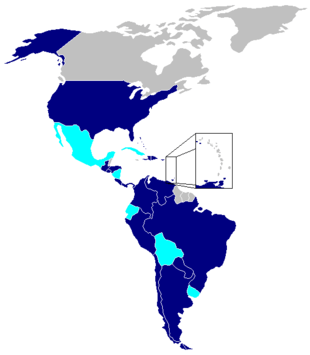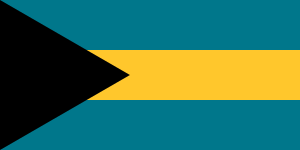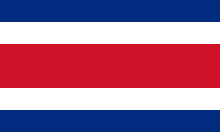Inter-American Treaty of Reciprocal Assistance
The Inter-American Treaty of Reciprocal Assistance (commonly known as the Rio Treaty, the Rio Pact, the Treaty of Reciprocal Assistance, or by the Spanish-language acronym TIAR from Tratado Interamericano de Asistencia Recíproca) was an agreement signed in 1947 in Rio de Janeiro among many countries of the Americas.[2] The central principle contained in its articles is that an attack against one is to be considered an attack against them all; this was known as the "hemispheric defense" doctrine. Despite this, several members have breached the treaty on multiple occasions. The treaty was initially created in 1947 and came into force in 1948, in accordance with Article 22 of the treaty. The Bahamas was the most recent country to sign and ratify it in 1982.[1]
Long name:
| |
|---|---|
 Member states in dark blue, states that withdrew in cyan. (Representing 754,901,942 citizens) | |
| Signed | 2 September 1947[1] |
| Location | Rio de Janeiro[1] |
| Effective | 12 March 1948[1] |
| Condition | ratifications of two-thirds of the Signatory States |
| Signatories | 23[1] |
| Parties | 17[1] |
| Depositary | Pan American Union |
| Languages | English, French, Portuguese and Spanish |
Background and history
The United States maintained a hemispheric defense policy relative to European influence under the Monroe Doctrine since 1823, which became increasingly interventionist with the Roosevelt Corollary in 1904. During the 1930s the US had been alarmed by Axis overtures toward military cooperation with Latin American governments; apparent strategic threats against the Panama Canal were of particular concern. These were discussed in a series of meetings of the International Conference of American States and the 1936 Inter-American Conference for the Maintenance of Peace.[3] During the war Washington had been able to secure Allied support from all individual governments except Uruguay, which remained neutral, and Argentina, whose government was not recognized by the Allied powers.[3] Some countries had signed the Declaration by United Nations in early 1942 and more had signed by the end of 1945.
However, Latin American countries were largely sidelined from the Allied discussions of a postwar security order, held at Dumbarton Oaks. The Brazilian Ambassador Carlos Martins "protested the violation of inter-American norms of consultation in the preparation of postwar plans."[4] These protests led to a series of consultations and well as the Mexican proposal for an inter-American meeting. At the Inter-American Conference on the Problems of War and Peace, in Mexico City during February and March 1945, discussions of the post-war world order were held and produced the Act of Chapultepec.[3][5] The Act included a framework for the negotiation of a regional security treaty. It also shaped Latin American pressure during the United Nations conference in San Francisco for clauses in the UN Charter to facilitate regional collective defense, under Article 51.[4][6]
Initially, the security conference was due to be held in Rio de Janeiro in late 1945 or early 1946; however, disputes between the United States and Argentina's Juan Domingo Perón led to delays. U.S. and some Latin American concern about peronismo raised the possibility of including collective intervention to preserve democracy in the security conference.[7] During the delay, global tensions between the United States and Soviet Union grew. In light of the developing Cold War and following the statement of the Truman Doctrine, the US wished to make those new anti-communist commitments permanent, as did many anti-communist leaders in Latin America. The Inter-American Treaty of Reciprocal Assistance was the first of many so-called 'mutual security agreements',[8] and the formalization of the Act of Chapultepec. The treaty was adopted by the original signatories on 2 September 1947 in Rio de Janeiro (hence the colloquial name "Rio Treaty"). It came into force on 3 December 1948 and was registered with the United Nations on 20 December 1948.[1] Though the Cold War overtones of the Rio Treaty became increasingly evident, during the immediate post-war years, Long argues that it was more closely tied to pre-WWII regional antecedents and, even, Latin American diplomatic pressure. "Despite many Latin American concerns about the United States’ ultimately interventionist nature, Latin American diplomats cited the Monroe Doctrine and US-led Pan-Americanism in support of a grand bargain that would extend and institutionalize U.S. engagement while restricting unilateralism."[4] However, the United States' often considered adherence to the Treaty's principles of nonintervention as secondary to its Cold War concerns.
The treaty was invoked numerous times during the 1950s and 1960s, in particular supporting the United States' naval blockade unanimously during the Cuban Missile Crisis. With the exceptions of Trinidad and Tobago (1967) and The Bahamas (1982), no countries that became independent after 1947 have joined the treaty; Canada is yet to become a member, though it already has separate defense commitments with the US. During the Falklands War (1982), the United States favored the United Kingdom because Argentina had been the aggressor, and because Argentina had not been attacked, as did Chile and Colombia. This was seen by most Latin American countries as the final failure of the treaty.[9][10] In 2001, the United States invoked the Rio Treaty after the September 11 attacks. In September 2002, citing the Falklands example[11][12] and anticipating the Iraq War, Mexico formally withdrew from the treaty; after the requisite two years, Mexico ceased to be a signatory in September 2004.
In 2008, the Union of South American Nations (UNASUR) created a new regional security council to take care of their own defence issues.[13][14]
On 5 June 2012, ALBA countries Bolivia, Ecuador, Nicaragua and Venezuela, under the leadership of leftist governments, initiated the retirement from the TIAR,[15][16] a decision which the Obama Administration deplored as "unfortunate" but respected.[17] The treaty has been denounced by Nicaragua on 20 September 2012, Bolivia on 17 October 2012, Venezuela on 14 May 2013, and Ecuador on 19 February 2014.
In 2019 during the presidential crisis, the National Assembly of Venezuela, presided by opposition leader Juan Guaidó, opened talks on rejoining TIAR.[18] On 11 May, Guaidó sent a letter to Organization of American States (OAS) secretary Luis Almagro requesting that Venezuela be reinstated.[19] On 29 May 2019, the National Assembly approved its return to the Treaty in a preliminary discussion.[20] The National Assembly reiterated its approval to return to the treaty in July 2019.[21]
Members
Current members:[22]










.svg.png)


.svg.png)


.svg.png)
Former members:
.svg.png)





See also
Footnotes
- As of July 2019, reincorporation approved by the National Assembly and ratified by the OAS.[21] Nicolás Maduro administration denies membership.
- Suspended before withdrawn.
- Ratified in 2014.
- Lacalle Pou administration announced plans to rejoin the TIAR in 2020.[24]
Further reading
- Long, T. (2020). "Historical Antecedents and Post-World War II Regionalism in the Americas." World Politics.
References
- "B-29: INTER-AMERICAN TREATY OF RECIPROCAL ASSISTANCE (RIO TREATY)". Organization of American States. Retrieved 1 March 2014.
- n.d. (2013). "Inter-American Treaty of Reciprocal Assistance.". The Columbia Electronic Encyclopedia®. Columbia University Press. Retrieved August 31, 2018.
- Act of Chapultepec The Oxford Companion to World War II, 2001, I. C. B. Dear and M. R. D. Foot
- Long, Tom (April 2020). "Historical Antecedents and Post-World War II Regionalism in the Americas". World Politics. 72 (2): 214–253. doi:10.1017/S0043887119000194. ISSN 0043-8871.
- Act of Chapultepec: Declarations on Reciprocal Assistance and American Solidarity, March 3, 1945, Pillars of Peace, Documents Pertaining To American Interest In Establishing A Lasting World Peace: January 1941-February 1946, Book Department, Army Information School, Carlisle Barracks, Pa., May 1946
- Tillapaugh, J. (January 1978). "Closed Hemisphere and Open World? The Dispute Over Regional Security at the U.N. Conference, 1945". Diplomatic History. 2 (1): 25–42. doi:10.1111/j.1467-7709.1978.tb00420.x. ISSN 0145-2096.
- Long, Tom; Friedman, Max Paul (undefined/ed). "The Promise of Precommitment in Democracy and Human Rights: The Hopeful, Forgotten Failure of the Larreta Doctrine". Perspectives on Politics: 1–16. doi:10.1017/S1537592719002676. ISSN 1537-5927. Check date values in:
|date=(help) - "Alliances, Coalitions, and Ententes - The american alliance system: an unamerican tradition". Encyclopedia of the New American Nation. Advameg, Inc. 2018. Retrieved August 31, 2018.
- Sennes, Ricardo; Onuki, Janina; de Oliveira, Amacio Jorge (2006). "The Brazilian foreign policy and the hemispheric security". Revista Fuerzas Armadas y Sociedad. Santiago. 1 (SE). doi:10.1590/S0717-14982006000100001. ISSN 0717-1498. Retrieved 1 September 2018.
Additionally, the deep weakening of hemispheric relations occurred due to the American support, without mediation, to the United Kingdom in the Falklands war in 1982, which definitively turned TIAR in dead letter.
- Malamud, Carlos (30 September 2002). "México abandona el TIAR. Implicaciones continentales de la iniciativa" (PDF). Boletín Elcano (in Spanish). Real Instituto Elcano. 5: 1–5. ISSN 1696-3326. Retrieved 1 September 2018.
El episodio dejó un mal sabor de boca en muchas de las cancillerías latinoamericanas, que pensaban que el TIAR era un mero papel mojado o una herramienta sólo al servicio de EEUU.
- "OEA: México abandona el TIAR". BBC Mundo (in Spanish). Servicio Mundial de la BBC. BBC. 6 September 2002. Retrieved August 31, 2018.
- OAS official document: He cited the 1982 conflict over the Falkland Islands as a classic demonstration of the Treaty's failure
- "Nace UNASUR y alianza militar sin EE.UU". Archived from the original on 2011-07-24. Retrieved 2009-06-19.
- FILATINA (April 14, 2009). "La defensa regional en manos propias: UNASUR". BLOG DE FILATINA (Fundación Integradora Latinoamericana). Fundación Integradora Latinoamericana Ambiental. Retrieved 1 September 2018.
- Periódico La Jornada (6 June 2012). "Bolivia, Ecuador, Nicaragua y Venezuela dejan el mecanismo de defensa TIAR". La Jornada (in Spanish) (Mundo). DEMOS S.A. de C.V. Afp, Dpa, Xinhua y Reuters. p. 31. Retrieved 1 September 2018.
- "ALBA countries renounced the TIAR in OAS Assembly". Archived from the original on 2015-01-08. Retrieved 2013-06-01.
- "EEUU lamenta que Bolivia, Ecuador, Nicaragua y Venezuela se retiren de TIAR". El Universal (in Spanish). 6 June 2012. Archived from the original on 20 December 2013.
- Faiola, Anthony; DeYoung, Karen (7 May 2019). "Venezuela's Opposition Debates New Tactics". The Washington Post. Retrieved 9 May 2019.
- "Qué es TIAR, el tratado de defensa que Guaidó ve como opción para rescatar la democracia". TalCual (in Spanish). 14 May 2019. Retrieved 19 May 2019.
- Alvarado, Yudith (29 May 2019). "Asamblea Nacional aprobó en primera discusión adhesión al TIAR". El Universal. Retrieved 29 May 2019.
- "Venezuela rejoins regional defense treaty but Guaido warns it's no 'magic' solution". Reuters. 23 July 2019. Retrieved 23 July 2019.
- "Inter-American Treaty of Reciprocal Assistance (Rio Treaty)". Organization of American States. 8 August 2019. Retrieved 23 August 2019.
- "In support of Venezuela, Uruguay abandons the Rio Treaty".
- "Gobierno anunció el retiro de Uruguay de la Unasur y el reingreso al TIAR". El País (in Spanish). 10 March 2020. Retrieved 11 March 2020.